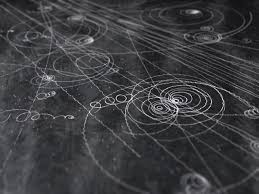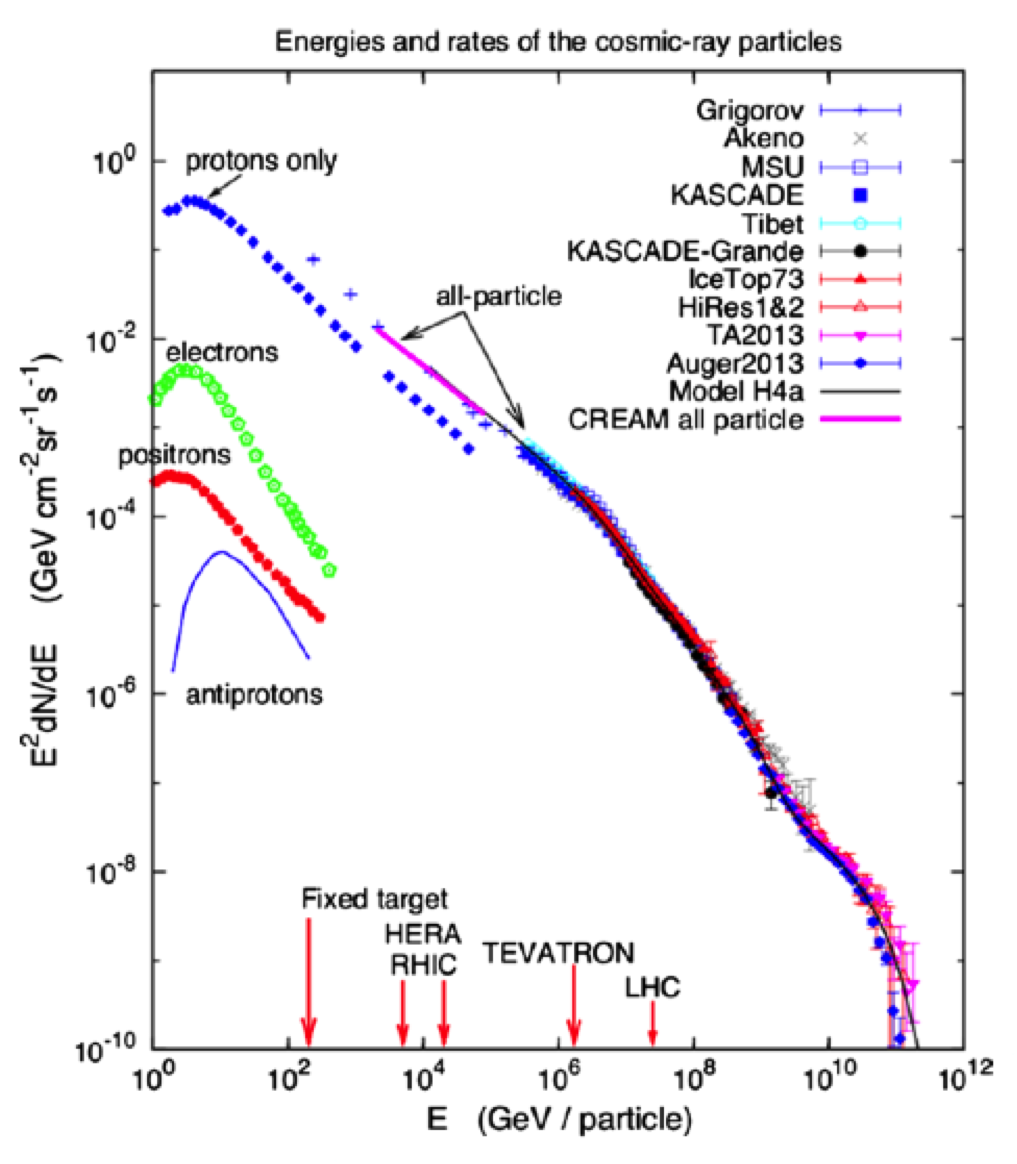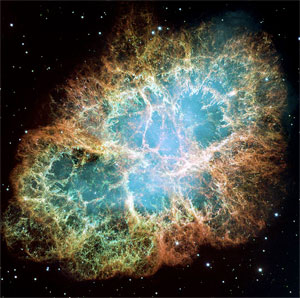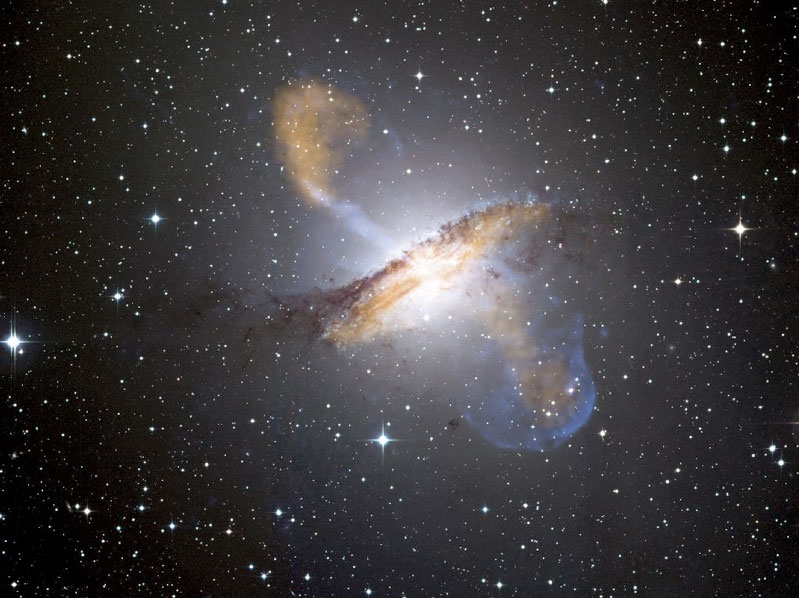Cosmic Rays
 Cosmic rays are energetic charged particles that reach us from the Cosmos, carrying information on the most energetic sources and violent phenomena in the Universe. The sources of these particles are believed to be different in different energy ranges, however the standard paradigm for the origin of CRs wants the majority of them to be produced by the remnants of Supernovae exploding in our Galaxy. In order for this to be true, Supernova Remnants (SNRs) must convert on average 10-20% of their energy into accelerated particles and the acceleration process must be quick enough so that energies of order 10 15 eV (=1PeV) are reached. The acceleration process has long been thought to be based on a mechanism called
Cosmic rays are energetic charged particles that reach us from the Cosmos, carrying information on the most energetic sources and violent phenomena in the Universe. The sources of these particles are believed to be different in different energy ranges, however the standard paradigm for the origin of CRs wants the majority of them to be produced by the remnants of Supernovae exploding in our Galaxy. In order for this to be true, Supernova Remnants (SNRs) must convert on average 10-20% of their energy into accelerated particles and the acceleration process must be quick enough so that energies of order 10 15 eV (=1PeV) are reached. The acceleration process has long been thought to be based on a mechanism called  As already mentioned, in order to account for the origin of Galactic
CRs, shock acceleration at an average SNR shock must take place with
an efficiency of tens of %. This implies that the backreaction of
the accelerated particles on the system can be very relevant: the
accelerated particles modify the shock dynamics and thermodynamics,
and perturb the ISM ahead of the shock. The first action is rich of
observational implications: downstream of a shock that efficiently
accelerates particles, the plasma is colder than in the absence of
particle acceleration, so that a temperature measurement can be
translated (after quite some effort in theoretical modeling) into a
measurement of particle acceleration efficiency. Concerning the
perturbations induced by the accelerated particles in the ISM, the
most relevant aspect is the amplification of the ambient magnetic
field up to 100 times its average value. This effect, not only has
observational consequences and provides a viable explanation for the
puzzling high magnetic field strength estimated in several Galactic
SNRs, but most importantly it increases the speed of the acceleration
process and makes it possible to reach PeV energies in SNRs, where
acceleration would otherwise proceed too slowly.
In the last decade or so our group has been heavily engaged in the development of a theory for the description of efficient shock acceleration including all the complex chain of non-linear effects involved. At the same time we have put much effort in the detailed emission modeling, within our theoretical framework, of the most interesting SNRs, so as to constrain their properties as CR accelerators based on multi-wavelength observations. The pursuit of such activity is more and more urgent in view of the large amount of gamma-ray data of unprecedented quality that will come from CTA. This next generation gamma-ray telescope has among its main scientific goals the quest for the origin of Cosmic Rays, and detailed dynamical and radiation modeling of the potential sources is essential to fully exploit the potential of gamma-ray observations to bring us this knowledge.
As already mentioned, in order to account for the origin of Galactic
CRs, shock acceleration at an average SNR shock must take place with
an efficiency of tens of %. This implies that the backreaction of
the accelerated particles on the system can be very relevant: the
accelerated particles modify the shock dynamics and thermodynamics,
and perturb the ISM ahead of the shock. The first action is rich of
observational implications: downstream of a shock that efficiently
accelerates particles, the plasma is colder than in the absence of
particle acceleration, so that a temperature measurement can be
translated (after quite some effort in theoretical modeling) into a
measurement of particle acceleration efficiency. Concerning the
perturbations induced by the accelerated particles in the ISM, the
most relevant aspect is the amplification of the ambient magnetic
field up to 100 times its average value. This effect, not only has
observational consequences and provides a viable explanation for the
puzzling high magnetic field strength estimated in several Galactic
SNRs, but most importantly it increases the speed of the acceleration
process and makes it possible to reach PeV energies in SNRs, where
acceleration would otherwise proceed too slowly.
In the last decade or so our group has been heavily engaged in the development of a theory for the description of efficient shock acceleration including all the complex chain of non-linear effects involved. At the same time we have put much effort in the detailed emission modeling, within our theoretical framework, of the most interesting SNRs, so as to constrain their properties as CR accelerators based on multi-wavelength observations. The pursuit of such activity is more and more urgent in view of the large amount of gamma-ray data of unprecedented quality that will come from CTA. This next generation gamma-ray telescope has among its main scientific goals the quest for the origin of Cosmic Rays, and detailed dynamical and radiation modeling of the potential sources is essential to fully exploit the potential of gamma-ray observations to bring us this knowledge.
 While for a long time signs of efficient CR acceleration in SNRs have been looked for mostly in terms of non-thermal radiation, and hence mainly in the radio, X-ray and gamma-ray band, important recent developments have come from optical line-emission. Efficient CR acceleration is bound to modify the shock in terms of heating the plasma upstream and cooling that downstream. If the shock is expanding in a medium that is only partially rather than totally ionized, signs of these effects can be found in the H_\alpha emission profile, which must show anomalous widths, with respect of the prediction of standard shock dynamics. We have explored this phenomenon in detail highlighting surprising effects that had been overlooked in previous treatments and that affect both the prediction of the H_\alpha emission profile (with the appearance of a new component) and the spectrum of accelerated particles. Comparison of the newly developed theoretical framework with upcoming observations should allow us to to put extremely good constraints on the efficiency of particle acceleration in a number of Galactic SNRs expanding in a partially ionized medium.
Other fundamental recent developments have come from experiments
directly measuring the CR flux reaching Earth, such as PAMELA, CREAM
and AMS02. Their measurements have highlighted a number of unexpected
features in the spectra of several different CR components. The
energetic particles that reach Earth are mostly protons and heavier
nuclei, with a minor fraction of electrons and an even smaller
fraction of elementary anti-matter, namely positrons and
anti-protons. Some of the most puzzling findings of the last 5-10
years are: 1) the spectra of all nuclei show an unexpected flattening
at an energy of order 300 GeV; 2) the flux ration of positrons to
electrons increases with increasing energy rather than decreasing as
expected; 3) the flux ratio of anti-protons to protons becomes
constant with increasing energy rather than decreasing as
expected.
These models have challenged the standard description of CR propagation throughout the Galaxy, giving rise to several ``unorthodox’’ proposals on the origin and transport of galactic CRs. Our group has tried to explain them within the more or less standard description of CR origin and propagation, finding that all the listed features can be accounted for taking into account two facts: 1) pulsars provide a non-negligible source of leptonic antimatter in the Galaxy and their contribution is likely to be at the origin of the observed positron excess; 2) low energy particles are numerous enough to modify the scattering properties of the ISM, so that diffusive propagation is likely different for low and high energy CRs, and this effect naturally translates into a spectral break in the hundreds of GeV energy range.
The consequences of both these suggestions are still waiting to be
fully explored, another urgent task in view of the upcoming new
particle (AMS02 and ISSCREAM) and gamma-ray (HAWC and later CTA) data.
While for a long time signs of efficient CR acceleration in SNRs have been looked for mostly in terms of non-thermal radiation, and hence mainly in the radio, X-ray and gamma-ray band, important recent developments have come from optical line-emission. Efficient CR acceleration is bound to modify the shock in terms of heating the plasma upstream and cooling that downstream. If the shock is expanding in a medium that is only partially rather than totally ionized, signs of these effects can be found in the H_\alpha emission profile, which must show anomalous widths, with respect of the prediction of standard shock dynamics. We have explored this phenomenon in detail highlighting surprising effects that had been overlooked in previous treatments and that affect both the prediction of the H_\alpha emission profile (with the appearance of a new component) and the spectrum of accelerated particles. Comparison of the newly developed theoretical framework with upcoming observations should allow us to to put extremely good constraints on the efficiency of particle acceleration in a number of Galactic SNRs expanding in a partially ionized medium.
Other fundamental recent developments have come from experiments
directly measuring the CR flux reaching Earth, such as PAMELA, CREAM
and AMS02. Their measurements have highlighted a number of unexpected
features in the spectra of several different CR components. The
energetic particles that reach Earth are mostly protons and heavier
nuclei, with a minor fraction of electrons and an even smaller
fraction of elementary anti-matter, namely positrons and
anti-protons. Some of the most puzzling findings of the last 5-10
years are: 1) the spectra of all nuclei show an unexpected flattening
at an energy of order 300 GeV; 2) the flux ration of positrons to
electrons increases with increasing energy rather than decreasing as
expected; 3) the flux ratio of anti-protons to protons becomes
constant with increasing energy rather than decreasing as
expected.
These models have challenged the standard description of CR propagation throughout the Galaxy, giving rise to several ``unorthodox’’ proposals on the origin and transport of galactic CRs. Our group has tried to explain them within the more or less standard description of CR origin and propagation, finding that all the listed features can be accounted for taking into account two facts: 1) pulsars provide a non-negligible source of leptonic antimatter in the Galaxy and their contribution is likely to be at the origin of the observed positron excess; 2) low energy particles are numerous enough to modify the scattering properties of the ISM, so that diffusive propagation is likely different for low and high energy CRs, and this effect naturally translates into a spectral break in the hundreds of GeV energy range.
The consequences of both these suggestions are still waiting to be
fully explored, another urgent task in view of the upcoming new
particle (AMS02 and ISSCREAM) and gamma-ray (HAWC and later CTA) data.

 Arcetri High Energy Group
Arcetri High Energy Group 